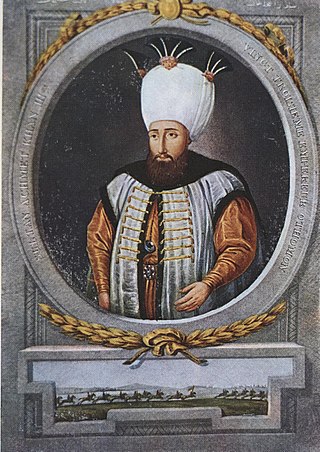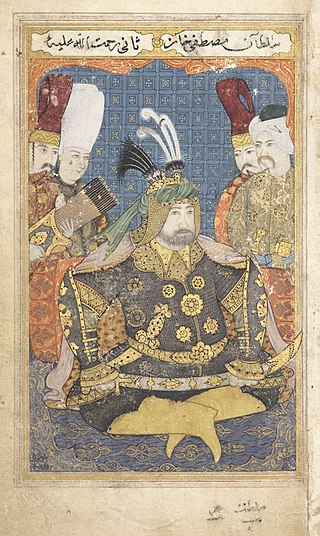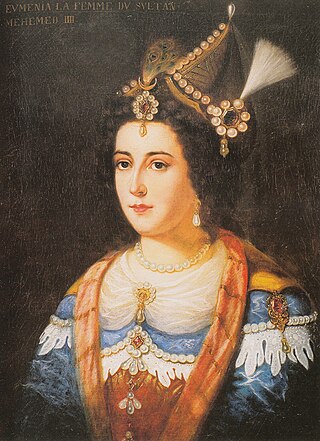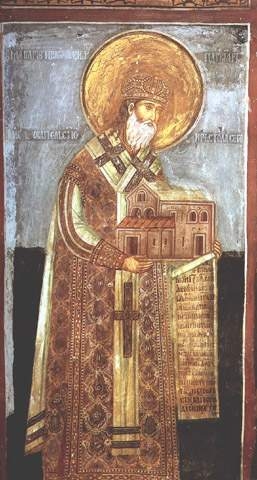
Ahmed I was sultan of the Ottoman Empire from 1603 until his death in 1617. Ahmed's reign is noteworthy for marking the first breach in the Ottoman tradition of royal fratricide; henceforth, Ottoman rulers would no longer systematically execute their brothers upon accession to the throne. He is also well known for his construction of the Blue Mosque, one of the most famous mosques in Turkey.

Ahmed II was the Sultan of the Ottoman Empire from 1691 to 1695.

Ahmed III was Sultan of the Ottoman Empire and a son of Sultan Mehmed IV. His mother was Gülnuş Sultan, originally named Evmania Voria, who was an ethnic Greek. He was born at Hacıoğlu Pazarcık, in Dobruja. He succeeded to the throne in 1703 on the abdication of his brother Mustafa II (1695–1703). Nevşehirli Damat İbrahim Pasha and the Sultan's daughter, Fatma Sultan directed the government from 1718 to 1730, a period referred to as the Tulip Era.

Murad IV was the Sultan of the Ottoman Empire from 1623 to 1640, known both for restoring the authority of the state and for the brutality of his methods. Murad IV was born in Constantinople, the son of Sultan Ahmed I and Kösem Sultan. He was brought to power by a palace conspiracy when he was just 11 years old, and he succeeded his uncle Mustafa I. Until he assumed absolute power on 18 May 1632, the empire was ruled by his mother, Kösem Sultan, as nāʾib-i salṭanat (regent). His reign is most notable for the Ottoman–Safavid War, of which the outcome would partition the Caucasus between the two Imperial powers for around two centuries, while it also roughly laid the foundation for the current Turkey–Iran–Iraq borders.

Mustafa II was the sultan of the Ottoman Empire from 1695 to 1703.

Mehmed IV, also known as Mehmed the Hunter, was the Sultan of the Ottoman Empire from 1648 to 1687. He came to the throne at the age of six after his father was overthrown in a coup. Mehmed went on to become the second-longest-reigning sultan in Ottoman history after Suleiman the Magnificent. While the initial and final years of his reign were characterized by military defeat and political instability, during his middle years he oversaw the revival of the empire's fortunes associated with the Köprülü era. Mehmed IV was known by contemporaries as a particularly pious ruler, and was referred to as gazi, or "holy warrior" for his role in the many conquests carried out during his long reign.
Gedik Ahmed Pasha was an Ottoman statesman and admiral who served as Grand Vizier and Kapudan Pasha during the reigns of sultans Mehmed II and Bayezid II.

Handan Sultan was a consort of Ottoman Sultan Mehmed III, and mother and Valide Sultan to their son Sultan Ahmed I.

The Köprülü era was a period in which the Ottoman Empire's politics were frequently dominated by a series of grand viziers from the Köprülü family. The Köprülü era is sometimes more narrowly defined as the period from 1656 to 1683, as it was during those years that members of the family held the office of grand vizier uninterruptedly, while for the remainder of the period they occupied it only sporadically.

Emetullah Rabia Gülnuş Sultan was the Haseki Sultan of Ottoman Sultan Mehmed IV and Valide sultan to their sons Mustafa II and Ahmed III. In the early 18th century, she became the most powerful and influential woman in the Ottoman Empire.
Şehsuvar Sultan was a consort to the Ottoman Sultan Mustafa II and Valide sultan to their son Osman III.

The Edirne Incident was a janissary revolt that began in Constantinople in 1703. The revolt was a reaction to the consequences of the Treaty of Karlowitz and Sultan Mustafa II's absence from the capital. The rising power of the sultan’s former tutor, Şeyhülislam Feyzullah Efendi and the empire's declining economy caused by tax farming were also causes of the revolt. As a result of the Edirne Event, Şeyhülislam Feyzullah Efendi was killed, and Sultan Mustafa II was ousted from power. The sultan was replaced by his brother, Sultan Ahmed III. The Edirne Event contributed to the decline of the power of the sultanate and the increasing power of the janissaries and kadis.
Dukaginzade Ahmed Pasha born Progon Dukagjini was a high-ranking statesman and military commander of the Ottoman Empire in the early 16th century. He hailed from the Albanian Dukagjini family, one of the strongest in pre-Ottoman medieval Albania.

Melek Ahmed Pasha was an Ottoman statesman and grand vizier during the reign of Mehmed IV.
Rami Mehmed Pasha (1645–1706) was an Ottoman statesman and poet who served as Grand Vizier (1703) and governor of Cyprus and of Egypt (1704–06). He was known as a poet of divan literature.
Halime Sultan was a consort of Sultan Mehmed III, and the mother of Sultan Mustafa I. The first woman to be Valide Sultan twice and the only to be Valide twice of a same son. She had at least four children with Mehmed: two sons Şehzade Mahmud and Mustafa I, and two daughters Hatice Sultan and Şah Sultan. She was de facto co-ruler as Valide Sultan from 22 November 1617 to 26 February 1618 and from 19 May 1622 to 10 September 1623, because her son was mentally instable. Halime was also one of the prominent figures during the era known as the Sultanate of Women.

Gevherhan Sultan was an Ottoman princess, daughter of Sultan Ahmed I and Kösem Sultan, half-sister of Sultan Osman II, and sister of Sultans Murad IV (1623–1640) and Ibrahim of the Ottoman Empire.
Fatma Sultan, was an Ottoman princess, daughter of Sultan Ahmed III and his BaşKadin Emetullah Kadın. She was politically active and influential on the affairs of state during the late Tulip era (1703–1730).

Ottoman Serbs were ethnic Serbs who lived in the Ottoman Empire (1453–1922). Ottoman Serbs, who were Serbian Orthodox Christian, belonged to the Rum Millet. Although a separate Serbian millet was not officially recognized during Ottoman rule, the Serbian Church was the legally confirmed representative organization of the Serbs in the Ottoman Empire.
Emine Sultan was an Ottoman princess, daughter of Sultan Mustafa II and half-sister of Sultans Mahmud I and Osman III of the Ottoman Empire.












